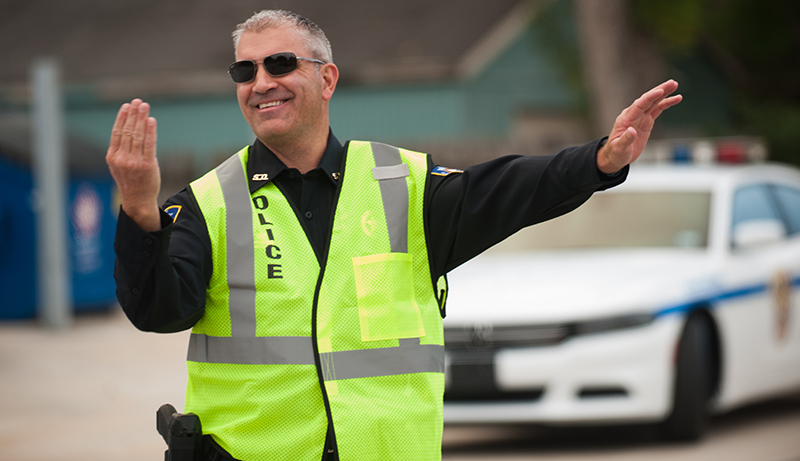Officer Palmer had the minimum allowable limits on his auto insurance the first time he was injured-on-duty. Thankfully, he changed this before he was injured a second time…
CRITICAL CHANGES TO MASSACHUSETTS AUTO INSURANCE POLICY
It was a fall Sunday morning and Ms. Jones got a later start than she wanted on her drive to morning mass at her local church. On the way, ironically, she came to a different church where mass just ended. Worshippers exit the church parking lot and drive in the direction of Police Officer Palmer. Officer Palmer is working this detail and is dressed in highly visible, green reflective clothing. Ms. Jones is not happy that she may be late for her church service. Approaching Officer Palmer, Ms. Jones loudly beeps her horn and tailgates the vehicle in front of her. Officer Palmer holds up both his arms, signaling Ms. Jones to stop her vehicle. She makes eye contact with Officer Palmer and reluctantly stops her car. Ms. Jones leans on her horn again and slams both her hands on the steering wheel. Without warning, Ms. Jones revs her engine and drives forward at Officer Palmer. At the last second Officer Palmer turns toward the driver’s side of Ms. Jones’ vehicle, narrowly avoiding being run over; however, Officer Palmer is unable to completely avoid danger. Ms. Jones drives over Officer Palmer’s foot and lower leg with her left rear tire. Officer Palmer yells at Ms. Jones to stop, but she accelerates, fleeing the scene.
Fortunately, Officer Palmer was able to obtain her plate number. Later that day the police question Ms. Jones. She claims she did not think her vehicle hit Officer Palmer. Ms. Jones is charged with multiple offenses including negligent operation of a motor vehicle and failure to stop for police. By the time Ms. Jones pleads guilty to these changes a few months later, Officer Palmer is still out of work and at home recovering from ankle surgery. Regrettably, Officer Palmer ends up needing a second surgery in order to remove screws that were installed in his ankle during the first procedure. His recovery, which included two nights of in-patient care, was complicated by an infection. After a short period of physical therapy, and ten months after being injured, Officer Palmer returned to work.
Officer Palmer knew he needed a Massachusetts car accident lawyer specializing in police injuries on duty, and contacted our police injury law firm following his injury.
This was not the first time that Officer Palmer hired our Massachusetts car accident law firm to represent him after being injured-on-duty due to a motorist’s negligence. A few years prior, his police cruiser was crashed into by another vehicle. He sustained various injuries, the most significant of which was to his hand, which required surgery. In all, Officer Palmer’s injuries kept him out of work for nearly four months following that incident. Although Officer Palmer had a very valuable case, his recovery was restricted to the defendant’s $50,000.00 policy limit. He deserved additional compensation for his injuries, but Officer Palmer only carried the minimal $20,000.00 in Underinsured Motorist Benefits Coverage on his personal automobile insurance policy. Officer Palmer’s auto insurer was entitled to reduce his $20,000.00 policy limit by the $50,000.00 recovered from the defendant. Effectively, Officer Palmer’s personal auto insurance was rendered useless in this situation.
Thankfully, Officer Palmer followed my advice to increase his Underinsured Motorist Benefits coverage to $250,000.00, which he had in place when he was injured by Ms. Jones. Ms. Jones had $100,000.00 of coverage to benefit anyone injured by her negligent driving. Her insurance company initially adopted her version that she did not drive over Officer Palmer’s foot before switching to a new and equally baseless defense that his injuries and need for two surgeries somehow related to a prior injury to the same foot. Insurers often resort to alleged prior injuries and pre-existing conditions as a last line of defense, even though for decades the law has been clear in Massachusetts that injured people can recover for aggravations of pre-existing conditions. After a brief back and forth we settled Officer Palmer’s claim with the defendant’s insurer for her $100,000.00 policy limit.
After subtracting the $100,000.00 collected from the defendant’s insurance company from Officer Palmer’s $250,000.00 underinsurance policy limit, there remained up to $150,000.00 in underinsurance coverage available that we could collect from his company. Given that Officer Palmer increased his coverages at my recommendation after the first incident, I was particularly happy to have been able to report to Officer Palmer that I had secured a $150,000.00 policy limit offer from his own auto insurer.
As this case shows, it is imperative for everyone, but especially police officers, to carry the maximum $250,000.00 per person policy limit on their personal automobile insurance policies for injuries caused by Uninsured Motorists (i.e. Defendants with no insurance. For example, non-permissive use or stolen vehicle) and Underinsured Motorists (i.e. Defendant’s auto insurance coverage is exceeded by the value of the injuries). To learn more about how these coverages can protect police officers injured on duty when the injury somehow involves a motor vehicle, please watch a recording of our free Webinar Protect Yourself and Detail Income By Changing Your Auto Insurance Coverages.
Injured in a Vehicle or Motorcycle Crash? Contact BallinLaw For A Free Consultation
If you or anyone you know has been injured in a vehicle or motorcycle crash, or as a pedestrian, please reach out to us as soon as possible. Visit BallinLaw to learn more about how we help victims injured in vehicle and motorcycle crashes.
In order to protect the privacy of the injured officer and witnesses, all names have been changed. Any resemblance to names of real persons, past or present, is merely coincidental and not intended. The injured officer agreed to have this article published in order that public safety officers around the Commonwealth be better educated about their legal rights to compensation when injured.


